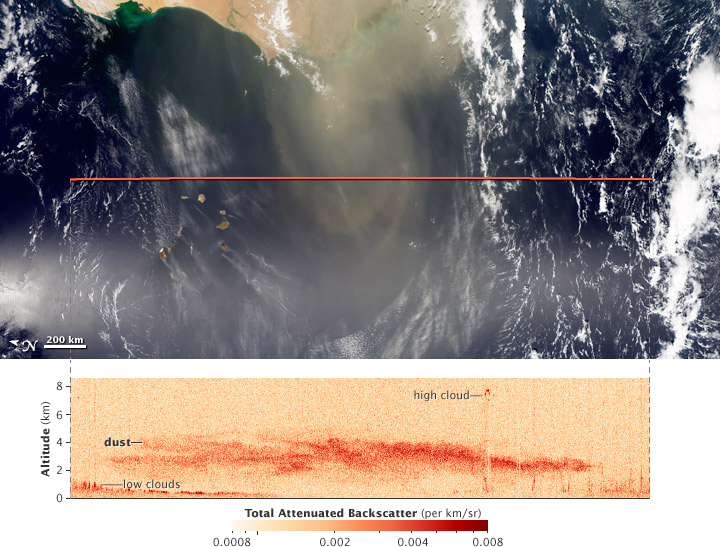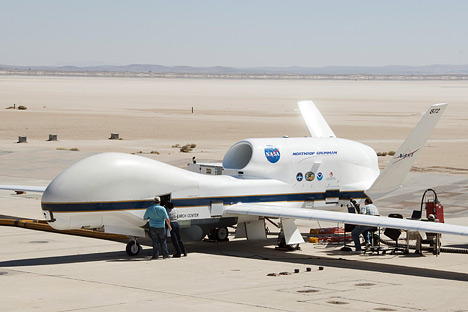

Although it became clear about 40 years ago that aerosols could affect climate, the measurements needed to establish the magnitude of such effects—or even whether specific aerosol types warm or cool the surface—were lacking.
The situation has improved considerably. Today scientists use an array of satellite, aircraft, and ground-based instruments to monitor aerosols. Radiometers—instruments that quantify the amount of electromagnetic radiation (light)—are among the most important tools available. The key quantity they report is aerosol optical depth (AOD), a measure of the amount of light that aerosols scatter and absorb in the atmosphere (and generally prevent from reaching the surface). An optical depth of less than 0.05 indicates a clear sky with relatively few aerosols and maximum visibility, whereas a value of 1 indicates hazy conditions. Optical depths above 2 or 3 represent very high concentrations of aerosols.

Aerosol optical depth is the fundamental measurement of quantity and distribution of aerosols. This map shows the average distribution of aerosols from June 2000 through May 2010, measured by the Multi-angle Imaging Spectroradiometer (MISR). Red indicates high concentrations of aerosols, beige indicates low concentrations. (NASA map by Robert Simmon, based on MISR data.)
Aerosol monitoring instruments also measure single scattering albedo (SSA), the fraction of light that is scattered compared to the total. Values for most aerosols range from about 0.7 for very absorbing particles to 1 for aerosols that only scatter light.
The first satellite instrument capable of crudely monitoring aerosol optical depth from space—the Advanced Very High Resolution Radiometer (AVHRR)—retrieved optical depth from measurements in the visible and near-infrared spectrum, beginning in the late 1970s. AVHRR, a passive radiometer, measured the intensity of sunlight as it reflected off aerosols, using the dark ocean as the background.
Over subsequent decades, the instruments have grown more sophisticated and made it possible to study aerosols over the land as well. Newer radiometers such as the Multi-angle Imaging Spectroadiometer (MISR) and the Moderate Resolution Imaging Spectroradiomer (MODIS) are capable of viewing aerosols at many more angles and wavelengths, providing more accurate results.

Newer instruments also provide insight into properties of light that AVHRR couldn’t detect. The Cloud Aerosol Lidar and Infrared Pathfinder Satellite Observer (CALIPSO) uses a laser-based technology that provides detailed vertical profiles of aerosol plumes and clouds. A French instrument, the Polarization and Directionality of the Earth’s Reflectances (POLDER) offers insight into the orientation—or polarization—of light waves as they move through the atmosphere. This previously unmeasured quantity has proven helpful in retrieving particle type information. An instrument even more sensitive to the polarization of light, the Aerosol Polarimetery Sensor (APS), will gather additional insights after its launch aboard NASA’s Glory mission in 2011.

Starting in 2011, the Glory mission will enable scientists to better characterize the types and distribution of aerosols. (NASA image by Ryan Zuber, GSFC Scientific Visualization Studio.)
Satellites provide a critical global perspective for understanding how aerosols affect Earth’s climate, but they are far from the only source of information. Networks of ground-based sensors are used to validate satellite measurements and offer some of the most accurate measurements of AOD available.
NASA co-sponsors a global network of ground sensors called the Aerosols Robotic Network, or AERONET, which is comprised of more than 200 carefully calibrated sun photometers measuring aerosol optical depth around the world. The relatively simple instruments deduce the amount and type of aerosol in the sky by measuring the intensity of light under cloud-free conditions. Aircraft and other ground stations deploy in situ instruments that measure certain aerosol properties with greater accuracy, but less frequently.


Land-based and airborne instruments complement NASA’s satellites. AERONET is a global network of sun photometers that measures aerosols from the ground, such as this station in the Canadian Arctic (top). The Global Hawk Uninhabited Aerial Vehicle (bottom) can carry several instruments to measure aerosols from the air. Photograph by Ovidiu Pancrati, ©2007 CANDAC. Lower photograph by Tony Landis/NASA.)
Despite great progress, many questions remain about the competing impacts of aerosols. Measuring particles within clouds remains challenging. Different types of particles can clump together to form hybrids that are difficult to distinguish. And changes in humidity or temperature can cause drastic changes in how certain aerosols behave and interact with cloud droplets.
Most importantly, the quantitative uncertainties in the amount of aerosols, and especially aerosol properties, need to be reduced. Only better measurements—and the more sophisticated computer modeling such measurements make possible—will provide the critical information that scientists need to fully integrate aerosol impacts into climate models and to reduce uncertainty about how the climate will change.